2011-2012 1. Sharpening our focus on complex files
Providing exemplary service to Canadians who complain to us about how institutions have handled their access to information requests is our overarching goal.
Facts and figures of interest
- We closed nearly 1,500 files, with an emphasis on complex cases.
- We have closed more than 7,400 complaints since April 1, 2008, and reduced our inventory by 21 percent over that time.
- We achieved 99 percent of this result by working cooperatively with institutions and complainants to satisfactorily resolve complaints.
- We have closed all but 51 of the most complex complaints we had on file, from prior to April 1, 2008.
- Eighty-eight percent of our inventory of complaints is made up of complaints involving an institution refusing to release information to requesters. Just five years ago, refusals accounted for only half of complaints.
The year 2011–2012 was one of transition for us in many ways. We made a conscious decision to tackle some of our most complex files. These included cases involving exemptions for national security, defence and international affairs, and a large group of complaints focused on the Canada Revenue Agency and the Canadian Broadcasting Corporation. We also pursued a single investigation into an instance of political interference with the access process, and sought to close the remaining, most complex, files in our inventory, dating from before April 1, 2008. These alone presented considerable challenges to our investigators, due to the subject matter, volume of pages and the passage of time.
We also entered 2011–2012 with our inventory composed largely of refusal files (those about information being exempted or excluded, no records or no response). Overall, these tend to require more extensive investigations than do administrative complaints and, consequently, take more time. Over the year, we also received fewer administrative complaints than we had in the previous two reporting periods.
This change in the content of our inventory is among the fruits of our success in effectively investigating administrative complaints (those dealing with delays, fees, time extensions and miscellaneous matters), as we had intended to do when we brought in our new business model in 2008.
At the same time, however, our evolving caseload challenged us to find new and more efficient ways of investigating the more complex refusal complaints. These are detailed below. The net result was that for the third year in a row we were able to close more files than we received. In total, we closed 1,496 files, which allowed us to make a further, albeit small, dent in our inventory. Since April 1, 2008, we have reduced our inventory by 21 percent, closing more than 7,400 complaints.
The changing complaints picture
Incoming complaints in 2011–2012 dropped 20 percent from 2010–2011—from 1,828 to 1,465 (Figure 1). Except for in 2010–2011—when we received an unusually high number of complaints in July 2010, due to one requester making 237 complaints—the number of new complaints has consistently declined over the last four years.
| Complaints received | Commissioner-initiated complaints | Total | |||||||
|---|---|---|---|---|---|---|---|---|---|
| 2009–2010 | 2010–2011 | 2011–2012 | 2009–2010 | 2010–2011 | 2011–2012 | 2009–2010 | 2010–2011 | 2011–2012 | |
| Complaints carried over from the previous year | 2,513 | 2,083 | 1,833 | 1 | 3 | 20 | 2,514 | 2,086 | 1,853 |
| New complaints | 1,653 | 1,810 | 1,460 | 36 | 18 | 5 | 1,689 | 1,828 | 1,465 |
| Complaints discontinued during the year* | 575 | 692 | 642 | 0 | 0 | 0 | 575 | 692 | 642 |
| Complaints settled during the year | n/a | 18 | 34 | n/a | 0 | 0 | n/a | 18 | 34 |
| Complaints completed during the year with findings | 1,508 | 1,350 | 819 | 34 | 1 | 1 | 1,542 | 1,351 | 820 |
| Total complaints closed during the year | 2,083 | 2,060 | 1,495 | 34 | 1 | 1 | 2,117 | 2,061 | 1,496 |
| Total inventory at year-end | 2,083** | 1,833+ | 1,798 | 3 | 20 | 24 | 2,086 | 1,853 | 1,822 |
*We discontinue complaints at the request of complainants, often after a substantial amount of investigative work has been put into the file.
**Includes 127 complaints on hold pending ongoing litigation.
+Includes 190 complaints on hold pending ongoing litigation.
This decrease is largely accounted for by a reduction in the number of administrative complaints we received. This is consistent with the trends we have observed across all institutions—in particular those we studied for our report cards process that implemented our recommendations. In 2011–2012, we had 433 new administrative complaints to investigate, compared to 931 in 2010–2011. This decrease continues what we see as a positive downward trend: since 2008–2009 the number of new administrative complaints has dropped by 58 percent. In particular, the number of complaints about institutions’ use of time extensions decreased 77 percent, from 630 in 2008–2009 to 147 in 2011–2012.
Over the same period, we received between 860 and 1,000 refusal complaints each year, including 994 in 2011–2012. With the drop in administrative complaints, then, refusal complaints have accounted for an increasingly large proportion of the complaints we have registered each year (Figure 2). In 2009–2010, for example, there was a near-even split between administrative and refusal complaints registered. Now, however, the ratio is closer to 70:30. (Cabinet confidence exclusion complaints—our third category of complaint—have accounted for between 2 percent and 3.5 percent of complaints registered in each of the past four years.)
Another significant trend we noticed was that complaints about missing records accounted for only 18 percent of the refusal complaints we received in 2011–2012, compared to 36 percent in 2008–2009. These are less complex than other refusal complaints, such as those about the use of exemptions. This decrease, in combination with a corresponding increase in exemption complaints we received, left us with a greater percentage of complex refusal files to investigate than in previous years.
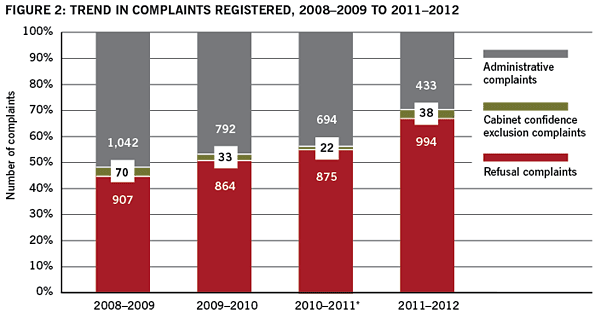
Text version of this graphic
Figure 2: Trend in complaints registered, 2008–2009 to 2011–2012
This bar chart shows the number of complaints we registered in each of 2008–2009, 2009–2010, 2010–2011 and 2011–2012 in three categories: administrative complaints, Cabinet confidence exclusion complaints and refusal complaints.
In 2008–2009, we received 1,042 administrative complaints, 70 Cabinet confidence exclusion complaints and 907 refusal complaints.
In 2009–2010, we received 792 administrative complaints, 33 Cabinet confidence exclusion complaints and 864 refusal complaints.
In 2010–2011, we received 694 administrative complaints, 22 Cabinet confidence exclusion complaints and 875 refusal complaints. We received 237 delay complaints (a type of administrative complaint) all at once. These have been removed from this chart for comparative purposes.
In 2011–2012, we received 433 administrative complaints, 38 Cabinet confidence exclusion complaints and 994 refusal complaints.
*The 237 delay complaints we received in July 2010 have been removed for comparison purposes.
The net result of the decrease in administrative complaints, combined with our efforts to improve how we process this type of complaint, is that our inventory of files is now largely composed of refusal cases. As Figure 3 shows, refusal complaints made up 88 percent of the inventory at year-end, administrative files were at 10 percent and the remaining 2 percent were Cabinet confidence exlusion complaints. This is a significant and positive change from five years ago, when administrative complaints accounted for 42 percent of our inventory and refusals for 50 percent. This means that our work is focused on the disclosure of substantive information rather than administrative matters.
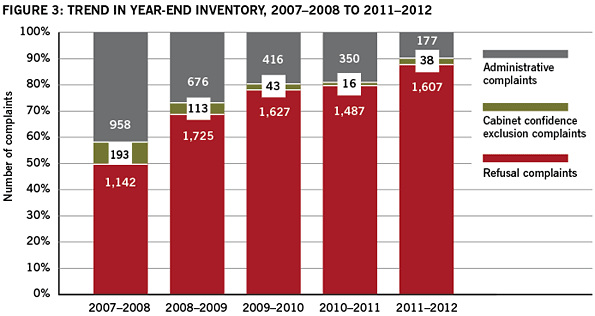
Text version of this graphic
Figure 3: Trend in year-end inventory, 2008–2009 to 2011–2012
This bar chart shows the number of complaints we had in our inventory at the end of each of 2007–2008, 2008–2009, 2009–2010, 2010–2011 and 2011–2012 in three categories: administrative complaints, Cabinet confidence exclusion complaints and refusal complaints.
At the end of 2007–2008, we had 958 administrative complaints, 193 Cabinet confidence exclusion complaints and 1,142 refusal complaints in our inventory.
At the end of 2008–2009, we had 676 administrative complaints, 113 Cabinet confidence exclusion complaints and 1,725 refusal complaints in our inventory.
At the end of 2009–2010, we had 416 administrative complaints, 43 Cabinet confidence exclusion complaints and 1,627 refusal complaints in our inventory.
At the end of 2010–2011, we had 350 administrative complaints, 16 Cabinet confidence exclusion complaints and 1,487 refusal complaints in our inventory.
At the end of 2011–2012, we had 177 administrative complaints, 38 Cabinet confidence exclusion complaints and 1,607 refusal complaints in our inventory.
Our productivity
We closed fewer files during this year of transition than during previous years, as Figure 4 shows. Recognizing this, we made some internal adjustments in order to increase the volume of files we could complete each month. As the year went along, and notwithstanding the complexity of the files, we were able to generally return to the results we had achieved in previous reporting periods.
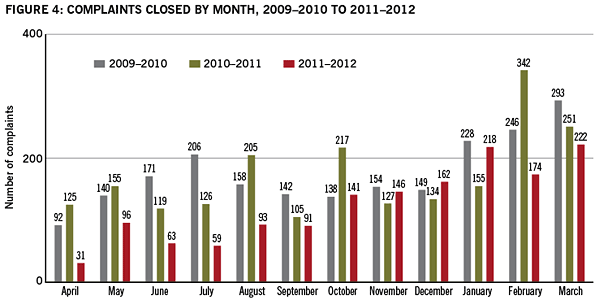
Text version of this graphic
Figure 4: Complaints closed by month, 2009–2010 to 2011–2012
This bar chart shows the number of complaints we closed in each month of the fiscal year in each of 2009–2010, 2010–2011 and 2011–2012.
In April, we closed 92 complaints in 2009–2010, 125 in 2010–2011 and 31 in 2011–2012.
In May, we closed 140 complaints in 2009–2010, 155 in 2010–2011 and 96 in 2011–2012.
In June, we closed 171 complaints in 2009–2010, 119 in 2010–2011 and 63 in 2011–2012.
In July, we closed 206 complaints in 2009–2010, 126 in 2010–2011 and 59 in 2011–2012.
In August, we closed 158 complaints in 2009–2010, 205 in 2010–2011 and 93 in 2011–2012.
In September, we closed 142 complaints in 2009–2010, 105 in 2010–2011 and 91 in 2011–2012.
In October, we closed 138 complaints in 2009–2010, 217 in 2010–2011 and 141 in 2011–2012.
In November, we closed 154 complaints in 2009–2010, 127 in 2010–2011 and 146 in 2011–2012.
In December, we closed 149 complaints in 2009–2010, 134 in 2010–2011 and 162 in 2011–2012.
In January, we closed 228 complaints in 2009–2010, 155 in 2010–2011 and 218 in 2011–2012.
In February, we closed 246 complaints in 2009–2010, 342 in 2010–2011 and 174 in 2011–2012.
In March, we closed 293 complaints in 2009–2010, 251 in 2010–2011 and 222 in 2011–2012.
Overall, the average turnaround time for complaints was 432 days, up from 413 in 2010–2011. Given that some of the files we closed this year were several years old, this result was not unexpected. However, we closed 49 percent of our files within nine months (Figure 5). In addition, the median turnaround time for all files, which better represents the service complainants can expect from us, was 276 days (about nine months) in 2011–2012. We continue to focus our efforts on improving this performance.
During 2011–2012, we also worked toward our goal of closing 85 percent of administrative complaints within 90 days. In the face of a decrease in the number of investigators dedicated to these complaints in the first half of the year, we were able overall just to maintain our productivity but not improve upon it (28 percent closed in 90 days compared to 32 percent the year before). We did return to a full complement of investigators by the end of the year and also sought throughout the reporting period new ways to streamline the process and developed new tools for investigators, such as report templates. Figures for the first quarter of 2012–2013 already show a definite improvement.
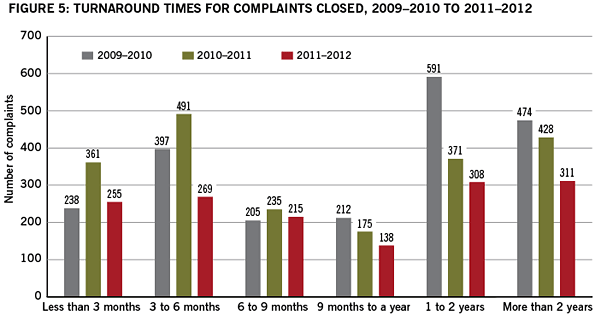
Text version of this graphic
Figure 5: Turnaround times for complaints closed, 2009–2010 to 2011–2012
This graph shows how long it took us to close complaints in three fiscal years: 2009–2010, 2010–2011 and 2011–2012. There are six time frames represented: less than three months; three to six months; six to nine months; nine months to a year; one to two years; and more than two years.
We closed 238 complaints in less than three months in 2009–2010, 361 in the same time frame in 2010–2011 and 255 in 2011–2012.
We closed 397 complaints in three to six months in 2009–2010, 491 in the same time frame in 2010–2011 and 269 in 2011–2012.
We closed 205 complaints in six to nine months in 2009–2010, 235 in the same time frame in 2010–2011 and 215 in 2011–2012.
We closed 212 complaints in nine months to a year in 2009–2010, 175 in the same time frame in 2010–2011 and 138 in 2011–2012.
We closed 591 complaints in one to two years in 2009–2010, 371 in the same time frame in 2010–2011 and 308 in 2011–2012.
We closed 474 complaints in more than two years in 2009–2010, 428 in the same time frame in 2010–2011 and 311 in 2011–2012.
Strategies to tackle our caseload
As the change in our caseload became apparent and we decided to tackle some of our oldest and most complex files, we assessed how to use our resources most effectively. We developed a number of new strategies for the investigation of refusal complaints while maintaining and fine-tuning our existing approaches.
To this end, we had an independent audit of our investigative function done in the spring of 2011. The audit confirmed the soundness of our processes and performance measures. It also provided the impetus to improve file documentation and environmental scanning to support effective and timely case management. In response, we prepared an overarching plan for investigations in 2011–2012 that helped us focus our activities and set goals for us to meet.
Older cases
As we entered 2011–2012, we had 115 cases left in our inventory dating from before April 1, 2008. These were among our most complex files, due to the issues involved and the passage of time since the initial access requests had been made. In fact, we had to restart investigations from the beginning in a number of instances. Many of these files featured a large volume of records, some with more than 10,000 pages each, and a large proportion involved the application of discretionary exemptions. Assessing each record in light of these exemptions and the passage of time was time-consuming. Our Strategic Case Management Team closed 64 such files in 2011–2012.
The remaining 51 complaints involve, among other things, issues relating to national security, defence and international affairs, or were on hold until recently, pending the resolution of litigation before the Federal Court of Appeal and the Supreme Court of Canada.
Complaints related to national security, defence and international affairs
Complaints about institutions’ use of exemptions under sections 13 and 15 of the Access to Information Act involve sensitive information concerning national security, defence and international affairs. These files come in at a steady rate of between 100 and 150 per year. However, they tend to require lengthy investigations and, as a result, have accumulated, such that we had more than 300 in our inventory at the beginning of 2011–2012 (or 17 percent of the total).
In July 2011, we assembled as a pilot project a special team dedicated to these complaints, in particular those involving subsection 15(1). This team, limited to eight investigators by the terms of the Access to Information Act, focused on complaints against six institutions (Foreign Affairs and International Trade Canada, Library and Archives Canada, National Defence, Privy Council Office, Canadian Security Intelligence Service and Canada Revenue Agency) that collectively accounted for more than 70 percent of our inventory of these complaints at the beginning of the year. We designed a process that would allow us to work through these files as quickly and effectively as possible while minimizing the impact on the institutions. We accomplished this by assigning specific investigators to institutions, thereby limiting the number of contact points, and by providing institutions with more information about our requirements at the front end of the investigative process.
At the start of the project, we drafted an advisory notice outlining our approach and consulted with the institutions. We incorporated much of their feedback into our processes and documentation. We are striving to foster open dialogue with institutions and to promote the disclosure of information, when releasing records would be in the public interest. Although this approach is to some extent more formal than that for many of our other investigations, we are finding that it is allowing us to advance files that have lingered for many years in a manner consistent with the recent jurisprudence of the Federal Court.
Our approach has shown signs of early success. We closed 109 of these files this year, discontinuing 71, completing 31 with findings and settling 7. Among the total were 54 files dating from 2008–2009 or before. In 23 instances, requesters received, as a result of our intervention, more information than had originally been disclosed.
With files related to national security, defence and international affairs comprising 20 percent of our cases at year-end, we have made this pilot project permanent.
Portfolio approach
In recent years, we have followed a portfolio approach, grouping complaints by institution or type of complainant, to develop expertise and efficiency in dealing with them. In 2011–2012, we used this approach to begin to address a large number of complaints that accounted for more than 30 percent of the inventory and involved two institutions—Canada Revenue Agency (CRA) and Canadian Broadcasting Corporation—and have made some progress. For example, using this approach, we were able to close 160 complaints against CRA from a single complainant. We intend to expand the use of the portfolio approach and refine it according to institutions’ business lines, exemptions invoked and subject matters.
Early resolution of complaints
This year, we expanded the focus of our Early Resolution team to include refusal complaints dealing with a small volume of records or a limited number of exemptions. This initiative was very successful, with the team closing 20 percent of these refusal files in fewer than 90 days. We will pursue this strategy in the coming year.
Delay complaints
This year, we increased the formality of our process for investigating complaints into delays—both extensions and deemed refusals. While, in the past, we spent long periods of time attempting to negotiate “commitment dates” (dates by which an institution commits to respond to a request that is late), we are now issuing more formal requests for work plans, including commitment dates. When an institution does not respond to our request or provides us with what we determine to be an unrealistic or unreasonable plan, we bring our concerns to the attention of the head of the institution. As the investigation summaries in Chapter 2 show, we addressed important issues in this manner, including excessive delay, improperly managed consultations and inadequate resourcing levels in access to information offices. We note that, in some instances, this formal process is the only way in which we can make the senior management of an institution aware of serious procedural and resourcing issues. Our approach has resulted in a number of positive developments in those institutions.
Making full use of our powers
We have broad investigative powers under the Access to Information Act, and we invoke them as needed when addressing complaints. They range from requesting relevant records from institutions, and compelling their production when necessary, speaking with individuals in private, conducting interviews, providing complainants and institutions with an opportunity to make oral and written representations, as well as seeking affidavit evidence.
In some cases, we hold formal inquiries to gather evidence, subpoenaing witnesses and documents, as required. If we find evidence of the possible commission of an offence, we may disclose information to the Attorney General of Canada.
When we determine that a complaint is well founded, the Commissioner reports her findings to the complainant and the institution. When she chooses to make formal recommendations to the head of the institution to resolve the issue (subsection 37(1) report), she provides him or her with an opportunity to respond before issuing her report to the complainant.
In 2011–2012, the Commissioner issued such a report for 17 complaints, which is an increase from 9 the year before and only 3 in 2009–2010. We also issued subpoenas for records or for witnesses to appear in two cases. This compares to one case in which we issued subpoenas over the previous two years. We initiated three cases before the Federal Court and intervened six times in cases before the Federal Court, the Federal Court of Appeal and the Nova Scotia Court of Appeal. While our use of these various tools has grown in recent years, we note that these cases equal only a small fraction of the nearly 1,500 complaints we closed in 2011–2012.
Moving to a proactive, more formal process
We strive to resolve matters with institutions informally. This approach, of course, depends on the willingness and ability of institutions to respond to our queries. In the face of delayed or insufficient responses in some instances this year, we increased the formality of our process. To mitigate the impact on institutions, however, our goal is to do more work at the front end of an investigation to ensure that our queries are targeted and that institutions are made better aware of our concerns.
Although this manner of proceeding has been very successful with a number of institutions, it has not been well received in all cases. Certain institutions have questioned and at times resisted our inquiries and have sought to limit our investigations to one point of contact within their access to information office. When the number of complaints against an institution is small, this might be feasible; however, in many instances it would be a hurdle to our staff and delay the completion of investigations.
Legal capacity
In 2011–2012, given the increased complexity of our inventory, we augmented our internal legal capacity to support the investigative function and conduct litigation at all court levels. This has lessened our reliance on costly external professional services. See Chapter 3 for information about our legal activities in 2011–2012. We were more active before the courts during the year than previously particularly in the context of section 44 applications by third parties seeking to prevent the disclosure of what they claim is confidential proprietary information held by government institutions.
Other facts and figures of note
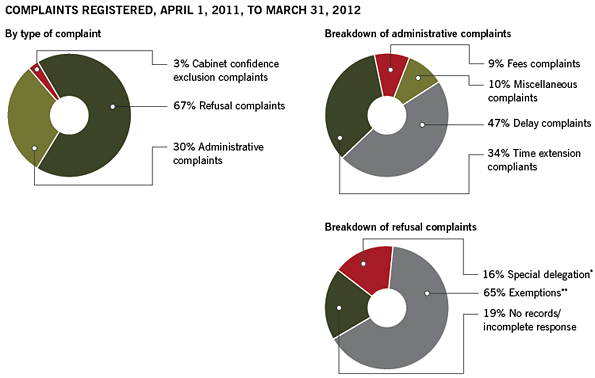
Text version of this graphic
Complaints registered, April 1, 2011, to March 31, 2012
These are three pie charts that show the proportion of various types of complaint we registered in 2011–2012.
The chart on the top left shows the proportion for each of three categories of complaint we receive: Clockwise from the top right, the first section shows 67 percent refusal complaints; the next 30 percent administrative complaints; and the last 3 percent Cabinet confidence exclusion complaints.
The chart on the top right shows the proportions of various types of administrative complaint we received. Clockwise from the top right, the first section shows 10 percent miscellaneous complaints; the next 47 percent delay complaints; the next 34 percent time extension complaints and the last 9 percent fees complaints.
The chart on the bottom right shows the proportions of various types of refusal complaint we received. Clockwise from the top right, the first section shows 65 percent exemption complaints (including exclusions under section 68, 68.1 and 68.2 of the Access to Information Act); the next 19 percent no records/incomplete response; and the last 16 percent special delegation complaints (those involving sensitive information concerning national security, defence and international affairs).
*Complaints involving sensitive information concerning national security, defence and internatioanl affairs
**Includes section 68, 68.1 and 68.2 exclusions
These graphs show the breakdown of the complaints we received in 2011–2012. As noted above, we received far fewer administrative complaints than in previous years, while the number of refusal complaints that came in remained in the range we have seen over the past few years. Within the pool of refusal complaints, we received 43-percent fewer no records/incomplete search complaints compared to 2008–2009. This was balanced by a corresponding increase in exemption complaints, which contributed to the overall increase in complexity of the files in our inventory.
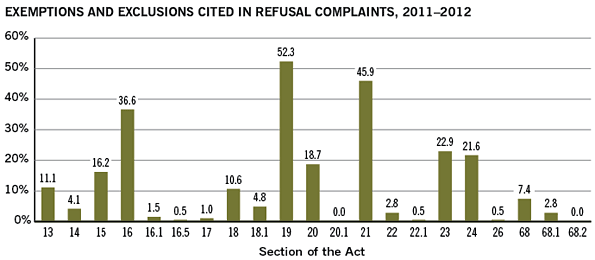
Text version of this graphic
Exemptions and exclusions cited in complaints, 2011–2012
This bar chart shows the proportion of the various exemptions cited in refusal complaints we registered in 2011–2012. These exemptions are included in various sections of the Access of the Information Act. Since a single complaint may cite multiple exemptions, the sum of all percentages exceeds 100 percent.
|
Section 13: 11.1 percent |
Section 20: 18.7 percent |
|
Section 14: 4.1 percent |
Section 20.1: 0.0 percent |
|
Section 15: 16.2 percent |
Section 21: 45.9 percent |
|
Section 16: 36.6 percent |
Section 22: 2.8 percent |
|
Section 16.1: 1.5 percent |
Section 22.1: 0.5 percent |
|
Section 16.5: 0.5 percent |
Section 23: 22.9 percent |
|
Section 17: 1.0 percent |
Section 24: 21.6 percent |
|
Section 18: 10.6 percent |
Section 26: 0.5 percent |
|
Section 18.1: 4.8 percent |
Section 68: 7.4 percent |
|
Section 19: 52.3 percent |
Section 68.1: 2.8 percent |
|
|
Section 68.2: 0.0 percent |
Note: The sum of all percentages may exceed 100 percent, because a single complaint may cite multiple exemptions.
As we sharpen our focus on refusal complaints, we note the distribution of exemptions and exclusions (those under sections 68, 68.1 and 68.2 of the Access to Information Act) associated with refusal complaints. This pattern, which is similar each year, highlights the most common reasons institutions withhold information.
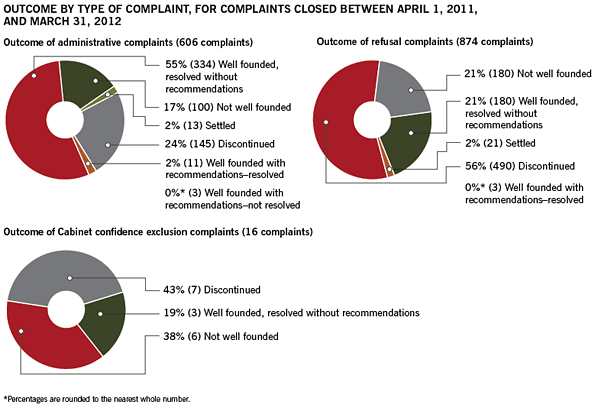
Text version of this graphic
Outcome by type of complaint, for complaints closed between April 1, 2011, and March 31, 2012
These are three pie charts that show the results of our investigations for three categories of complaint.
The chart on the top left sets out the outcomes for 606 administrative complaints. Clockwise from the top right, the first section shows the 55 percent of complaints (334) that were well founded, resolved without recommendations. The second section shows 17 percent (100 complaints) that were not well founded. This is followed by four sections, as follows: 2 percent (13 complaints) settled; 24 percent (145 complaints) discontinued; 2 percent (11 complaints) well founded with recommendations—resolved; and 0 percent (3 complaints) well founded with recommendations—not resolved. The percentages in this graph are rounded to the nearest whole number.
The chart on the top right sets out the outcomes for 874 refusal complaints. Clockwise from the top right, the first section shows the 21 percent of complaints (180) that were not well founded. The second section shows 21 percent (180 complaints) that were well founded, resolved without recommendations. This is followed by three sections, as follows: 2 percent (21 complaints) settled; 56 percent (490 complaints) discontinued; and 0 percent (3 complaints) well founded with recommendations—resolved. The percentages in this graph are rounded to the nearest whole number.
The chart on the bottom left sets out the outcomes for 16 Cabinet confidence exclusion complaints. Clockwise from the top right, the first section shows the 43 percent of complaints (7) that were discontinued. The second section shows 19 percent (3 complaints) that were well founded, resolved without recommendations. The third section shows 38 percent (6 complaints) that were not well founded. The percentages in this graph are rounded to the nearest whole number.
These graphs show the outcomes for the various types of complaint we investigate. The pattern has been fairly constant over the last three years. One exception, however, has been an increase in the proportion of refusal complaints we have discontinued over that period, from about 35 percent of complaints in 2009–2010 to 56 percent in 2011–2012. This change can be attributed, in large part, to our taking a portfolio approach to complaints involving the Canada Revenue Agency and the Canadian Broadcasting Corporation. We consolidated files according to subject matter and discontinued the individual complaints. Doing this facilitated the review of records by institutions, thereby reducing delay and ensuring faster resolution of the complaint.
| Canada Revenue Agency | 324 |
|---|---|
| National Defence | 74 |
| Canadian Broadcasting Corporation | 71 |
| Royal Canadian Mounted Police | 68 |
| Citizenship and Immigration Canada | 66 |
| Correctional Service of Canada | 65 |
| Foreign Affairs and International Trade Canada | 56 |
| Health Canada | 49 |
| Aboriginal Affairs and Northern Development Canada | 47 |
| Department of Justice Canada | 47 |
| Canada Post Corporation | 46 |
| Public Works and Government Services Canada | 45 |
| Canada Border Services Agency | 36 |
| Privy Council Office | 36 |
| Industry Canada | 34 |
| Others (73 institutions) | 401 |
| Total | 1,465 |
This chart lists the 15 institutions about which we received the most complaints in 2011–2012. Although the overall number of institutions subject to complaints has increased from 81 to 88 since 2008–2009, the top 15 institutions have remained fairly constant and accounted for roughly three quarters of all new complaints each year. The Canada Revenue Agency has been, by far, the number one subject of complaints over the past four years, with National Defence and the Canadian Broadcasting Corporation regularly appearing among the top five.
| Overall | With merit | Not well founded | |
|---|---|---|---|
| Canada Revenue Agency | 75 | 50 | 25 |
| Transport Canada | 57 | 48 | 9 |
| Royal Canadian Mounted Police | 54 | 32 | 22 |
| Canadian Broadcasting Corporation | 51 | 25 | 26 |
| Correctional Service of Canada | 49 | 28 | 21 |
| National Defence | 46 | 23 | 23 |
| Canada Post Corporation | 40 | 37 | 3 |
| Health Canada | 40 | 34 | 6 |
| Public Works and Government Services Canada | 40 | 20 | 20 |
| Aboriginal Affairs and Northern Development Canada | 32 | 31 | 1 |
| Industry Canada | 31 | 21 | 10 |
| Citizenship and Immigration Canada | 30 | 21 | 9 |
| Privy Council Office | 26 | 21 | 5 |
| Canada Border Services Agency | 25 | 14 | 11 |
| Foreign Affairs and International Trade Canada | 23 | 18 | 5 |
| Department of Justice Canada | 23 | 9 | 14 |
| Others (59 institutions) | 178 | 102 | 76 |
| Total | 820 | 534 | 286 |
This chart shows the outcomes for the 16 institutions for which we issued the most findings in 2011–2012.